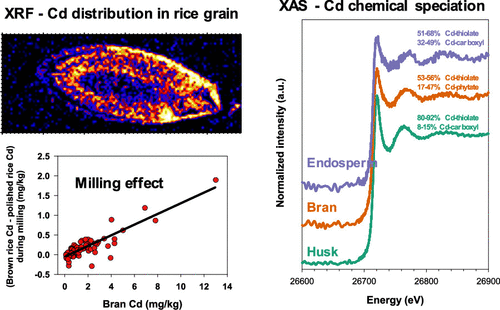当前位置:
X-MOL 学术
›
Environ. Sci. Technol.
›
论文详情
Our official English website, www.x-mol.net, welcomes your
feedback! (Note: you will need to create a separate account there.)
Chemical speciation and distribution of cadmium in rice grain and implications for bioavailability to humans.
Environmental Science & Technology ( IF 10.8 ) Pub Date : 2020-09-10 , DOI: 10.1021/acs.est.0c03001 Yi Gu 1, 2 , Peng Wang 1, 2 , Shen Zhang 1, 2 , Jun Dai 1, 2 , Hong-Ping Chen 1, 2 , Enzo Lombi 3 , Daryl L Howard 4 , Antony van der Ent 5 , Fang-Jie Zhao 1, 2 , Peter M Kopittke 6
Environmental Science & Technology ( IF 10.8 ) Pub Date : 2020-09-10 , DOI: 10.1021/acs.est.0c03001 Yi Gu 1, 2 , Peng Wang 1, 2 , Shen Zhang 1, 2 , Jun Dai 1, 2 , Hong-Ping Chen 1, 2 , Enzo Lombi 3 , Daryl L Howard 4 , Antony van der Ent 5 , Fang-Jie Zhao 1, 2 , Peter M Kopittke 6
Affiliation

|
Consumption of rice (Oryza sativa) is the major dietary source of cadmium (Cd) for populations with rice as the staple. Little is known about the distribution and chemical speciation of Cd in rice grain, which is critical in determining the bioavailability of Cd to humans. We used synchrotron-based techniques for analyses of the speciation and distribution of Cd in rice grain. The majority of the Cd in rice grain was present as Cd–thiolate complexes (66–92%), likely in the form of Cd bound with thiol-rich proteins. The remainder was present as Cd–carboxyl compounds and Cd–histidine. Elemental mapping showed two different patterns of Cd distribution, one with an even distribution throughout the entire grain and the other with a preferential distribution in the outer tissues (aleurone layer and outer starchy endosperm). The distribution pattern is important as it affects the removal of Cd during milling. On average, milling reduced grain Cd concentrations by 23.5% (median of 27.5%), although the range varied widely from a 64.7% decrease to a 22.2% increase, depending upon the concentration of Cd in the bran. We found that the variation in the distribution pattern of Cd in the rice grain was due to a temporal change in the supply of Cd from the soil porewater during grain filling. These results have important implications for Cd bioavailability in human diets.
中文翻译:

水稻籽粒中镉的化学形态和分布及其对人类生物利用度的影响。
食用大米(水稻)是以大米为主要食物的人群的主要膳食镉(Cd)来源。关于水稻籽粒中Cd的分布和化学形态知之甚少,这对于确定Cd对人类的生物利用度至关重要。我们使用基于同步加速器的技术来分析稻米中Cd的形态和分布。水稻籽粒中的大多数Cd以Cd-硫醇盐络合物(66-92%)的形式存在,可能以Cd与富含硫醇的蛋白质结合的形式存在。其余形式为Cd-羧基化合物和Cd-组氨酸。元素作图显示了两种不同的Cd分布模式,一种分布在整个谷物中,分布均匀,另一种分布在外部组织(神经元层和外部淀粉质胚乳)中。分布方式很重要,因为它会影响铣削过程中Cd的去除。平均而言,根据麸皮中Cd的浓度,碾磨可使谷物中的Cd浓度降低23.5%(中位数为27.5%),范围从降低的64.7%到增加的22.2%不等。我们发现,水稻籽粒中Cd分布模式的变化是由于谷物灌浆过程中土壤孔隙水中Cd的供应随时间变化而引起的。这些结果对人类饮食中镉的生物利用度具有重要意义。我们发现,水稻籽粒中镉的分布方式的变化是由于谷物灌浆过程中土壤孔隙水中镉的供应随时间的变化而引起的。这些结果对人类饮食中镉的生物利用度具有重要意义。我们发现,水稻籽粒中镉的分布方式的变化是由于谷物灌浆过程中土壤孔隙水中镉的供应随时间的变化而引起的。这些结果对人类饮食中镉的生物利用度具有重要意义。
更新日期:2020-10-06
中文翻译:

水稻籽粒中镉的化学形态和分布及其对人类生物利用度的影响。
食用大米(水稻)是以大米为主要食物的人群的主要膳食镉(Cd)来源。关于水稻籽粒中Cd的分布和化学形态知之甚少,这对于确定Cd对人类的生物利用度至关重要。我们使用基于同步加速器的技术来分析稻米中Cd的形态和分布。水稻籽粒中的大多数Cd以Cd-硫醇盐络合物(66-92%)的形式存在,可能以Cd与富含硫醇的蛋白质结合的形式存在。其余形式为Cd-羧基化合物和Cd-组氨酸。元素作图显示了两种不同的Cd分布模式,一种分布在整个谷物中,分布均匀,另一种分布在外部组织(神经元层和外部淀粉质胚乳)中。分布方式很重要,因为它会影响铣削过程中Cd的去除。平均而言,根据麸皮中Cd的浓度,碾磨可使谷物中的Cd浓度降低23.5%(中位数为27.5%),范围从降低的64.7%到增加的22.2%不等。我们发现,水稻籽粒中Cd分布模式的变化是由于谷物灌浆过程中土壤孔隙水中Cd的供应随时间变化而引起的。这些结果对人类饮食中镉的生物利用度具有重要意义。我们发现,水稻籽粒中镉的分布方式的变化是由于谷物灌浆过程中土壤孔隙水中镉的供应随时间的变化而引起的。这些结果对人类饮食中镉的生物利用度具有重要意义。我们发现,水稻籽粒中镉的分布方式的变化是由于谷物灌浆过程中土壤孔隙水中镉的供应随时间的变化而引起的。这些结果对人类饮食中镉的生物利用度具有重要意义。









































 京公网安备 11010802027423号
京公网安备 11010802027423号